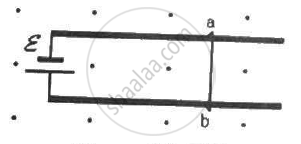Advertisements
Advertisements
प्रश्न
Suppose a charged particle moves with a velocity v near a wire carrying an electric current. So, a magnetic force acts on it. If the same particle is seen from a frame moving with velocity v in the same direction, the charge will be found to be at rest. Will the magnetic force become zero in this frame? Will the magnetic field become zero in this frame?
उत्तर
Magnetic force becomes zero as the particle is at rest in this frame of reference and we know that force on a particle,
F = qvBsin(θ">θ), where v is the velocity of the particle.
So, when v = 0, F = 0.
Magnetic field on the particles still exists because the current is independent of the frame of reference. For any reason, if the electrons of the wire seem to be at rest in a frame of reference, the protons are still flowing opposite to the frame of reference. Due to this, the current and the magnetic fields still exist.
APPEARS IN
संबंधित प्रश्न
Write the relation between the velocity of propagation and the magnitudes of electric and magnetic fields.
How does the path followed by the charge get affected if its velocity has a component parallel to \[\vec{B}\] .
Velocity of light in glass is 2 × 108 m/s and in air is 3 × 108 m/s. If the ray of light passes from glass to air, calculate the value of critical angle.
Figure shows a smooth pair of thick metallic rails connected across a battery of emf εhaving a negligible internal resistance. A wire ab of length l and resistance r can slide smoothly on the rails. The entire system lies in a horizontal plane and is immersed in a uniform vertical magnetic field B. At an instant t, the wire is given a small velocity vtowards right. (a) Find the current in it at this instant. What is the direction of the current? (b) What is the force acting on the wire at this instant? (c) Show that after some time the wire ab will slide with a constant velocity. Find this velocity.

What is the ratio of the velocity of the wave in the two media of refractive indices μ1 and μ2?
A potential difference V is applied across a conductor of length L and diameter D. How is the drift velocity, vd, of charge carriers in the conductor affected when (i) V is halved, (ii) L is doubled and (iii) D is halved ? justify your answer in each case.
In an inertial frame of reference, the magnetic force on a moving charged particle is `vec"F"`. Its value in another inertial frame of reference will be ______.
